Mani Rimdu Festival
Inspired by the Tibetan monastic dance tradition, Mani Rimdu blends cultural performance with spiritual practice, providing a unique way for the Sherpa people to connect with their religious beliefs and ancestral customs.
Inspired by the Tibetan monastic dance tradition, Mani Rimdu blends cultural performance with spiritual practice, providing a unique way for the Sherpa people to connect with their religious beliefs and ancestral customs.
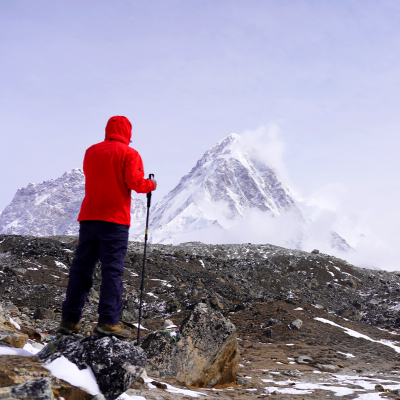
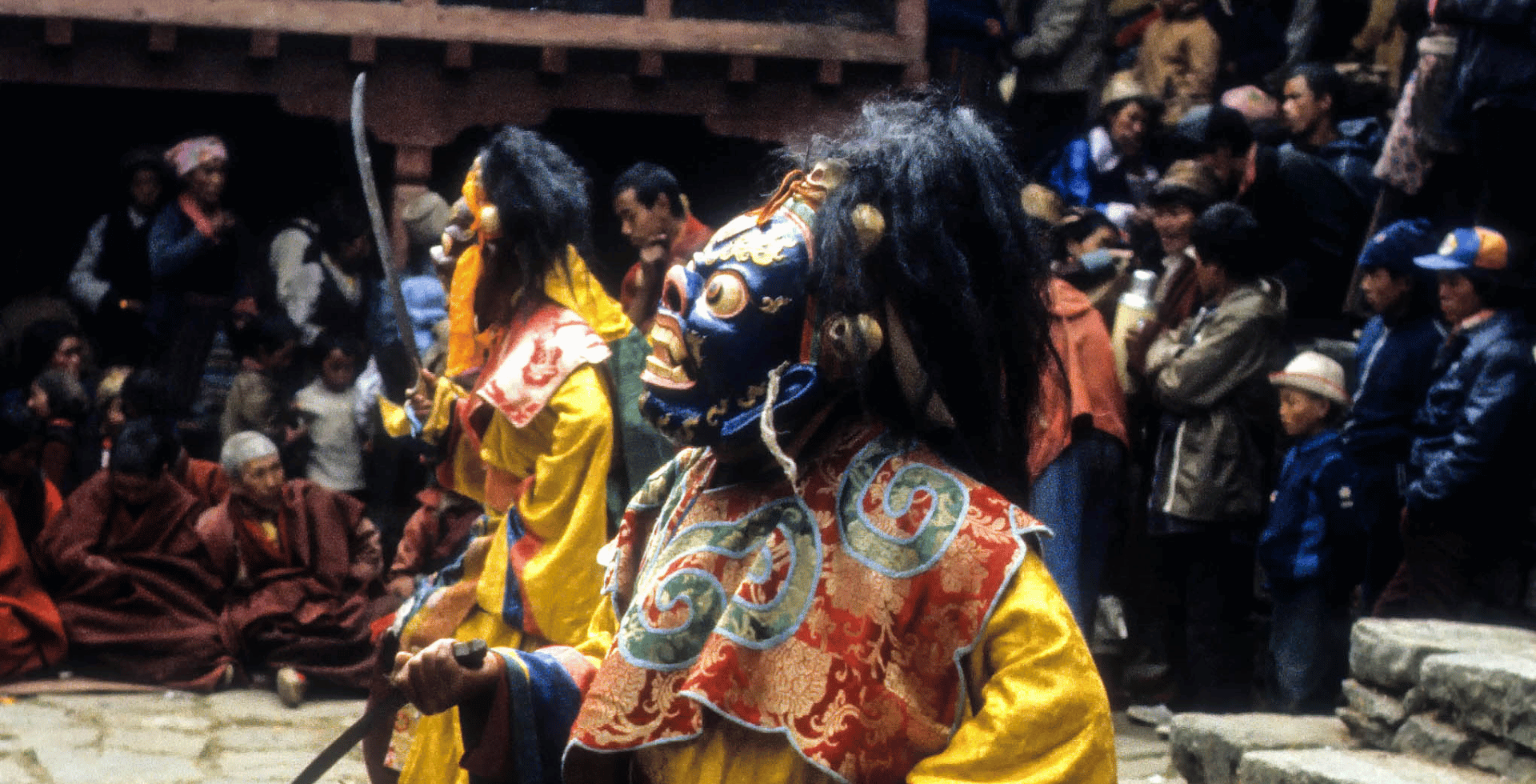
The Mani Rimdu Festival is a vibrant and deeply spiritual Nepalese festival celebrated by the Sherpa people in the Solu-Khumbu region. Rooted in Tibetan Buddhism, the festival takes place annually at various monasteries, including Tengboche, Thame, and Chiwong. Over several days, this colorful celebration features a series of sacred rituals, prayers, and masked dances that showcase the rich cultural heritage and religious traditions of the Sherpa community. Mani Rimdu serves not only as a vital means of preserving and strengthening these traditions but also as an opportunity for visitors to immerse themselves in the unique world of Sherpa culture and spirituality.
The Mani Rimdu Festival holds great significance for the Sherpa people and Buddhism for various reasons:
Preservation of culture and tradition: Mani Rimdu is an essential cultural event that helps maintain and pass down the centuries-old traditions and customs of the Sherpa people. The festival allows the younger generation to learn about their heritage and stay connected to their roots, ensuring that their unique customs are preserved for future generations.
Spiritual connection: As a deeply spiritual event, Mani Rimdu plays a crucial role in reinforcing the Sherpa community's connection to Tibetan Buddhism. The prayers, rituals, and dances performed during the festival symbolize various aspects of Buddhist teachings, helping the participants and observers strengthen their spiritual beliefs and understanding.
Blessings and positive energy: The Mani Rimdu Festival is believed to bring blessings and positive energy to the entire community. The sacred rituals performed during the event aim to dispel negative forces and promote peace, harmony, and prosperity in the region.
Community bonding: Mani Rimdu is a time for social gathering and bonding within the Sherpa community. People from different villages come together to celebrate, share stories, and strengthen their relationships, fostering a strong sense of unity and togetherness.
Cultural exchange and tourism: The Mani Rimdu Festival has gained popularity among international travelers, providing a unique opportunity for cultural exchange between the Sherpa community and visitors. By attending the festival, tourists can immerse themselves in the fascinating world of Sherpa culture and spirituality, while also contributing to the local economy through tourism. This cultural exchange helps promote understanding and appreciation of the diverse customs and beliefs that exist around the world.
In this blog post, we will explore the captivating world of the Mani Rimdu Festival and its importance to the Sherpa people and Buddhism. The key topics covered in this comprehensive guide include:
Historical Background of Mani Rimdu: Delve into the origin of the festival, its connection to Tibetan Buddhism, and its role in preserving Sherpa culture and tradition.
The Spiritual Significance of Mani Rimdu: Understand the three main phases of the festival—Wong, Cham, and Jinsak—and the spiritual meaning behind each of them.
Preparations for Mani Rimdu: Discover the intricate process of preparing for the festival, from determining the dates based on the lunar calendar to the monks' responsibilities and the creation of ritual items.
The Mani Rimdu Experience: Experience the festival through a day-by-day account, with vivid descriptions of the costumes, masks, music, and energy that bring this event to life.
Mani Rimdu Festival at Different Monasteries: Learn about the unique aspects of Mani Rimdu as celebrated at various monasteries, such as Tengboche, Thame, and Chiwong, and explore any regional differences and similarities.
Attending Mani Rimdu: A Traveler's Guide: Get practical tips for visitors planning to attend the festival, including the best time to visit, travel and accommodation advice, etiquette guidelines, and photography and videography recommendations.
By the end of this blog post, you will have gained a deeper understanding of the Mani Rimdu Festival's significance and the rich cultural heritage it represents, while also being equipped with the knowledge needed to attend and appreciate this incredible event.
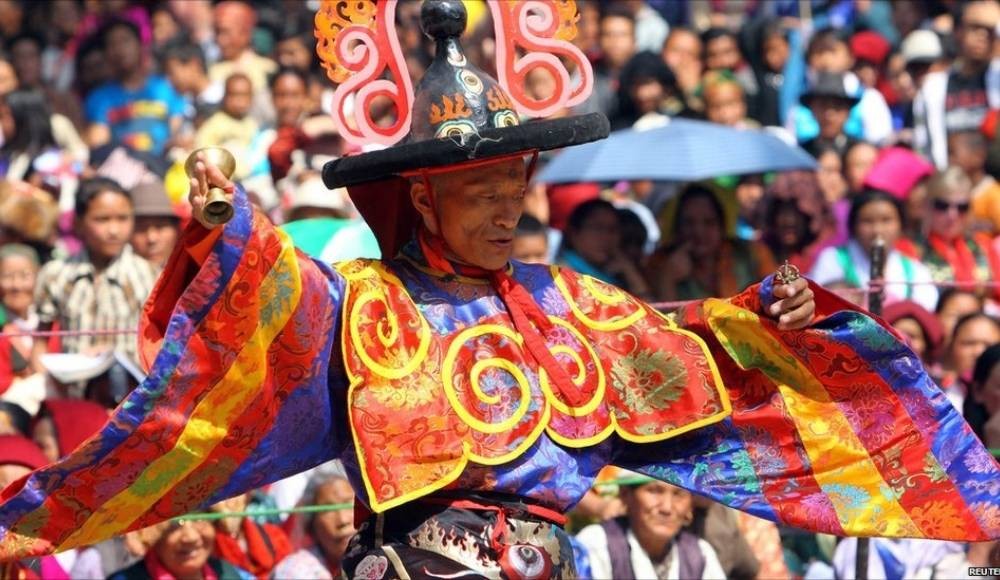
The Mani Rimdu Festival traces its roots back to the early 20th century when it was introduced by the renowned Tibetan Buddhist lama, Ngawang Tenzin Norbu. The festival is based on a series of sacred rituals that have been passed down through generations of Buddhist practitioners. Inspired by the Tibetan monastic dance tradition, Mani Rimdu blends cultural performance with spiritual practice, providing a unique way for the Sherpa people to connect with their religious beliefs and ancestral customs.
Mani Rimdu is deeply connected to Tibetan Buddhism, specifically the Nyingma sect, which is one of the oldest schools of Tibetan Buddhism. Many Sherpa people practice this form of Buddhism, and the Mani Rimdu Festival serves as a platform for them to celebrate and honor their faith. The festival incorporates various aspects of Tibetan Buddhist teachings and iconography, such as the use of sacred texts, intricate sand mandalas, and masked dances representing deities and historical figures.
Mani Rimdu plays a crucial role in preserving and promoting Sherpa culture and tradition. As a major annual event and one of the most popular mountain festivals, it brings together people from different villages and generations, creating a sense of unity and continuity within the community. The festival allows the Sherpa people to maintain a strong connection to their cultural roots, as it provides an opportunity for them to learn and practice their customs, rituals, and beliefs.
Moreover, Mani Rimdu contributes to the preservation of Sherpa culture by attracting visitors and fostering cultural exchange. As tourists come to witness the unique blend of spirituality, art, and performance, they develop a deeper understanding and appreciation for Sherpa culture and the rich heritage it represents. This increased awareness and respect can help ensure the survival and continued celebration of the Mani Rimdu Festival and the traditions it upholds.
The Mani Rimdu Festival holds deep spiritual significance for the Sherpa people and Tibetan Buddhists. It is a multi-day celebration consisting of various rituals, prayers, and performances that are designed to promote spiritual growth, remove obstacles, and garner blessings from the deities. The festival comprises three main phases, each carrying distinct spiritual meaning:
Wong (Empowerment): The first phase of the Mani Rimdu Festival is known as Wong, during which the head Lama or Rinpoche bestows blessings and empowerment upon the attendees. The participants receive a special initiation, which involves a ritual purification and an offering of a sacred thread. This phase is believed to confer spiritual protection and foster a strong connection with the deities.
Cham (Masked Dance): The second phase, Cham, is characterized by a series of elaborate masked dances performed by the monks. These dances depict various stories and legends from Tibetan Buddhism, portraying deities, demons, and other mythological beings. The purpose of the dances is to convey spiritual teachings and create a sacred atmosphere that helps to dispel negative energies and promote spiritual growth.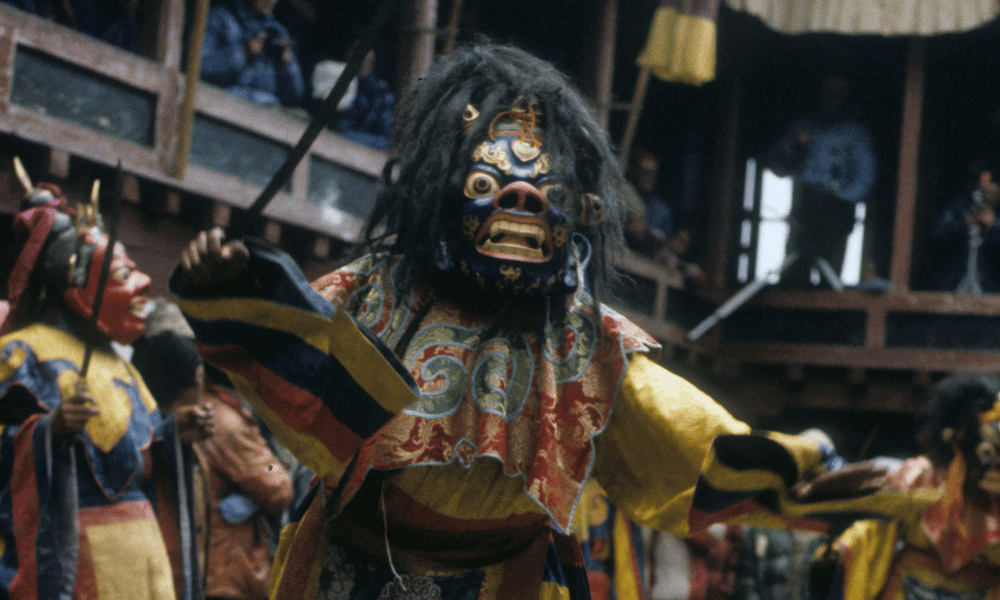
Jinsak (Fire Puja and Rituals): The final phase, Jinsak, consists of a fire puja and various other rituals performed by the monks. The fire puja is a powerful ceremony that symbolizes the destruction of ignorance and negative forces. Offerings are made to the fire, and prayers are recited to invite the blessings of the deities. The culmination of this phase is the dismantling of the sand mandala, which represents the impermanence of life and the importance of non-attachment.
Wong: The spiritual meaning of the Wong phase lies in the empowerment and blessings it bestows upon the participants. It helps them to establish a strong connection with the divine and reminds them of the importance of seeking spiritual guidance and protection.
Cham: The spiritual significance of the Cham phase is twofold. Firstly, the masked dances serve as a powerful medium for conveying Buddhist teachings and moral lessons, promoting mindfulness and spiritual growth. Secondly, the dances are believed to dispel negative energies and create a sacred atmosphere, fostering a sense of harmony and positivity within the community.
Jinsak: The Jinsak phase carries spiritual meaning through its emphasis on purification and transformation. The fire puja symbolizes the destruction of ignorance and negative forces, reminding the participants of the importance of overcoming obstacles and striving for spiritual enlightenment. The dismantling of the sand mandala reinforces the concept of impermanence, a central tenet of Buddhism, and encourages non-attachment.
The Mani Rimdu Festival plays a vital role in maintaining the Sherpa community's connection to Buddhism by providing a platform for spiritual practice and communal engagement. The festival not only deepens the community's understanding of Buddhist teachings but also brings them together in a shared spiritual experience that fosters unity, cultural pride, and a strong sense of belonging. By participating in the rituals, prayers, and performances, the Sherpa people reinforce their spiritual beliefs and strengthen their bond with the Buddhist tradition that forms an integral part of their cultural identity.
The dates of the Mani Rimdu Festival are determined according to the lunar calendar, which is of great importance in Tibetan Buddhism. The festival is usually held during the tenth month of the Tibetan calendar, called "Lha Bab," which typically falls in October or November. By following the lunar calendar, the festival aligns with specific auspicious days and astrological events, ensuring that the ceremonies and rituals are performed at the most spiritually favorable time.
Monks play a crucial role in the preparations for Mani Rimdu, as they are responsible for conducting the ceremonies and performing the sacred rituals. Their tasks include:
Reciting prayers and meditation: In the weeks leading up to the festival, the monks engage in intensive prayer and meditation sessions, focusing on the deities and spiritual aspects associated with Mani Rimdu.
Learning and rehearsing dances: The monks spend considerable time learning and practicing the intricate masked dances (Cham) that form a central part of the festival. This involves not only mastering the dance steps but also understanding the symbolism and meaning behind each performance.
Crafting masks and costumes: The monks are responsible for creating the elaborate masks and costumes used during the Cham dances. This requires a high level of skill and craftsmanship, as well as a deep understanding of the iconography associated with the various deities and mythological beings.
Creating the sand mandala and other important ritual items:
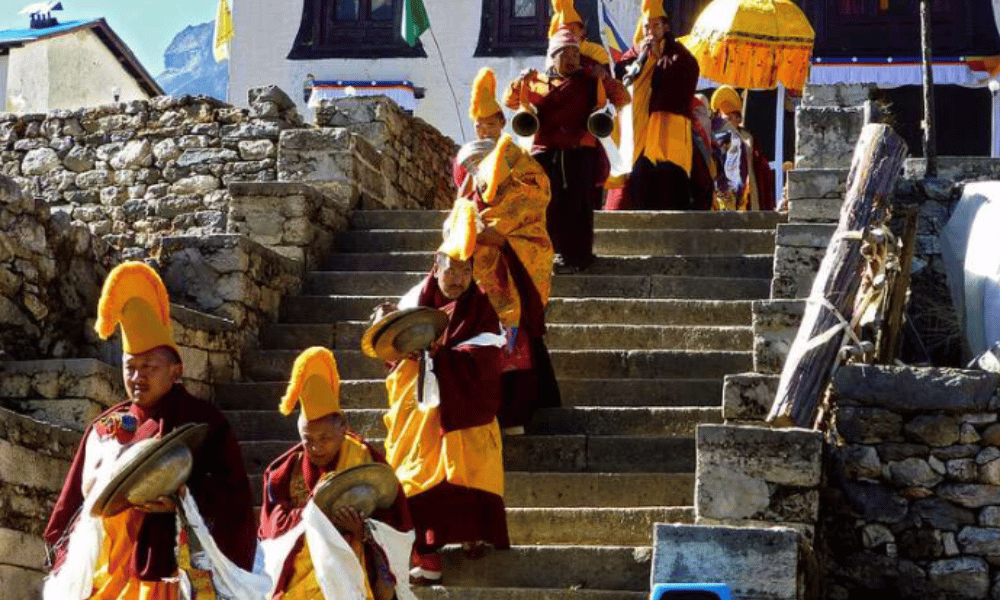
One of the most important aspects of the Mani Rimdu preparations is the creation of the sand mandala. Monks meticulously craft this intricate and colorful design using colored sand, which represents the universe and the divine realm. The mandala serves as a focal point for meditation and is believed to generate positive energy and blessings. Apart from the sand mandala, monks also prepare other ritual items such as tormas (sculpted offerings made from barley flour and butter) and prayer flags.
Local communities also play a significant role in preparing for Mani Rimdu. They clean and decorate their homes, make offerings, and cook special dishes to celebrate the festival. They also help prepare the monastery and its surroundings to accommodate the influx of visitors and ensure a comfortable and welcoming environment.
Visitors planning to attend Mani Rimdu should also make their own preparations. This includes researching the festival's customs and etiquette, arranging travel and accommodation, and ensuring they have appropriate clothing and gear for the weather conditions in the Everest region during the festival period.
Below is a day-by-day account of the festival:
The first day of the Mani Rimdu Festival, known as Wong, is dedicated to spiritual empowerment. The head lama or Rinpoche conducts a series of sacred rituals and prayers, bestowing blessings upon the attendees. Participants receive a special initiation, involving a ritual purification and the offering of a sacred thread. This day is marked by an atmosphere of reverence and devotion, as people seek spiritual protection and guidance from the divine.
On the second day, the festival transitions into the Cham phase, which features a series of elaborate masked dances performed by the monks. These dances depict stories and legends from Tibetan Buddhism, portraying various deities, demons, and mythological beings. The Cham performances captivate the audience with their vibrant costumes, intricate masks, and mesmerizing movements, accompanied by the rhythmic sounds of traditional instruments like drums, cymbals, and horns.
The third and final day of the festival, Jinsak, consists of a fire puja and other rituals conducted by the monks. The fire puja symbolizes the destruction of ignorance and negative forces, and offerings are made to the fire while prayers are recited. The climax of the festival is the dismantling of the sand mandala, which is followed by a procession where the sand is dispersed into a nearby river or stream, signifying the impermanence of life and the importance of non-attachment.
During the Mani Rimdu Festival, the costumes, masks, and music play a crucial role in creating a visually and aurally stunning experience. The costumes worn by the monks during the Cham dances are elaborate and colorful, featuring intricate patterns and designs that represent the specific deity or character they are portraying. The masks, carefully crafted by the monks, are equally elaborate and vivid, capturing the unique features and expressions of the deities and other beings.
The music that accompanies the festival is a powerful blend of traditional instruments, including drums, cymbals, horns, and bells. These instruments create a deeply evocative and rhythmic soundtrack that complements the dances and rituals, setting the tone for the entire event and enhancing the overall atmosphere.
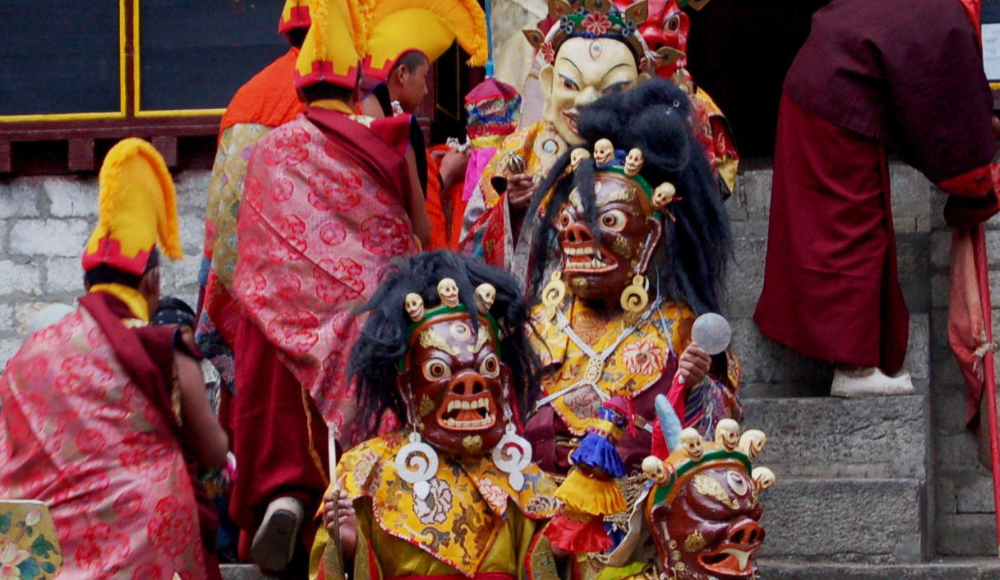
The Mani Rimdu Festival is characterized by an atmosphere of spiritual devotion, cultural pride, and communal unity. Attendees, both local and international, are drawn into the captivating world of Sherpa culture and Tibetan Buddhism, experiencing a unique blend of spirituality, art, and performance. The energy at the festival is infectious, as the community comes together to celebrate their shared heritage and beliefs, creating a sense of belonging and reinforcing the ties that bind them. For visitors, the Mani Rimdu Festival offers a rare opportunity to witness the rich cultural tapestry of the Sherpa people, leaving them with lasting memories and a deeper appreciation for the traditions that define this remarkable community.
The Mani Rimdu Festival is celebrated in several monasteries across the Everest region, each offering its own unique aspects and experiences. Some of the notable monasteries where the festival takes place include Tengboche, Thame, and Chiwong.
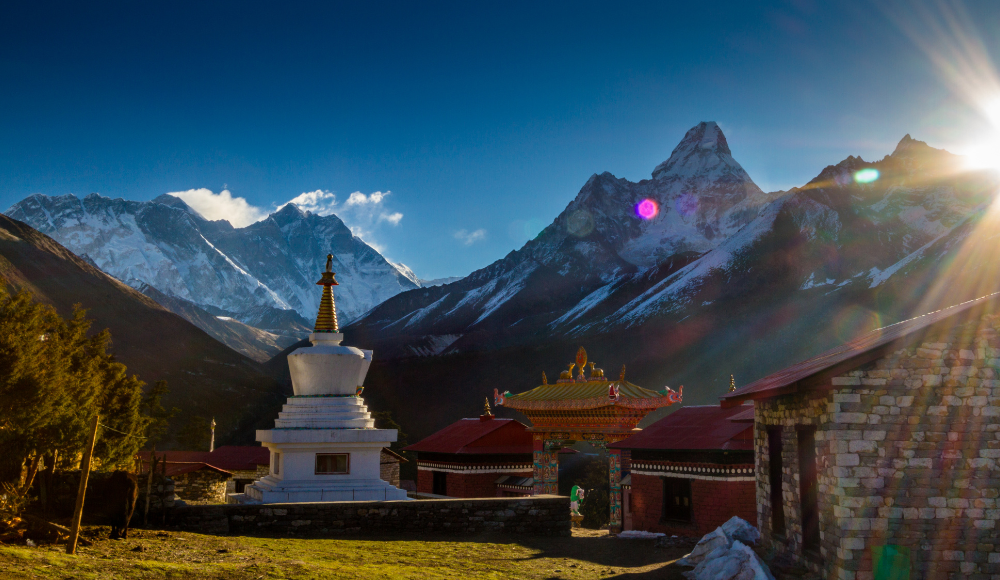
Tengboche Monastery, located in the Khumbu region, is one of the most famous places to experience the Mani Rimdu Festival. The festival at Tengboche is known for its grand scale and attracts a significant number of both local and international visitors. The monastery's stunning backdrop, with views of the Everest and Ama Dablam peaks, adds a unique charm to the celebrations. Tengboche Monastery is also renowned for the quality of its Cham performances, which are considered to be among the finest in the region.
Thame Monastery, situated in the Solu-Khumbu region, holds its own version of the Mani Rimdu Festival. While it shares many similarities with the celebrations at Tengboche, the festival at Thame is characterized by a more intimate atmosphere, as it attracts fewer tourists. This allows visitors to experience the festival in a more authentic and personal manner. Thame Monastery is also known for the "Dance of the Black Hat," a unique Cham performance that is not performed at all locations.
Chiwong Monastery, located on a hilltop near the village of Phaplu, offers another opportunity to witness the Mani Rimdu Festival. The festival at Chiwong Monastery is celebrated with great enthusiasm and is known for its vibrant masked dances and rituals. One unique aspect of the Chiwong celebration is the "Dance of the Drummers," a mesmerizing performance that features monks playing large drums while dancing in perfect synchrony.
While the core elements of the Mani Rimdu Festival, such as the Wong, Cham, and Jinsak phases, remain consistent across different monasteries, there can be some regional variations in terms of the specific dances, rituals, and customs. These differences can be attributed to the unique histories and traditions of each monastery, as well as the influence of local cultural practices.
Similarities between the celebrations at various monasteries include the use of intricate masks and costumes, the performance of Cham dances, the creation of sand mandalas, and the central role of monks in conducting ceremonies and rituals.
Despite the regional differences, the Mani Rimdu Festival at all locations shares the common goal of promoting spiritual growth, preserving Sherpa culture, and fostering a sense of unity and belonging within the community. No matter which monastery one chooses to visit, the Mani Rimdu Festival offers a deeply enriching and unforgettable experience.
We have crafted a basic outline for you to follow while planning your trip to attend the Mani Rimdu festival. Make sure to be respectful of the local culture and have a great time.
The Mani Rimdu Festival usually takes place during the tenth month of the Tibetan lunar calendar, called "Lha Bab," which typically falls in October or November. This is considered one of the best times to visit the Everest region, as the weather is generally stable with clear skies and moderate temperatures. However, it's important to keep in mind that the exact dates of the festival can vary, so it's essential to confirm the schedule before planning your trip.
Plan your trip early: Since Mani Rimdu attracts a significant number of visitors, it's important to book your flights, accommodation, and trekking permits well in advance. This will help ensure that you secure a spot at your preferred lodges and avoid any last-minute disappointments.
Hire a reputable trekking agency or guide: To make the most of your Mani Rimdu experience, consider hiring a local guide or joining a group tour organized by a reputable trekking agency. They can help you navigate the trekking route, provide information about the festival and local customs, and ensure that you have a safe and enjoyable journey.
Prepare for altitude: The Everest region is located at a high altitude, and attending the Mani Rimdu Festival often involves trekking to remote monasteries. Make sure to acclimatize properly, follow a gradual ascent schedule, and stay well-hydrated to minimize the risk of altitude sickness.
Pack appropriate clothing and gear: Ensure you have the right clothing and gear for the weather conditions in the Everest region during the festival period. This includes warm layers, waterproof clothing, and sturdy footwear.
Dress modestly: When attending the Mani Rimdu Festival, it's important to dress modestly and respectfully. Avoid wearing revealing or provocative clothing, and consider wearing traditional attire such as a "bakhu" or "chuba" to show your respect for local customs.
Be respectful during ceremonies: While attending the festival, remain quiet and respectful during prayers, rituals, and dance performances. Avoid talking loudly, laughing, or engaging in any behavior that could be considered disrespectful.
Seek permission before entering restricted areas: Some areas within the monasteries may be off-limits to visitors. Always ask for permission before entering any restricted areas, and follow the instructions given by the monks or local guides.
Always ask for permission: Before taking any photographs or videos during the festival, always ask for permission from the monks or local guides. Some monasteries may have restrictions on photography or videography, and it's important to respect these rules.
Be mindful of your surroundings: When taking photographs or videos, be mindful of your surroundings and avoid obstructing the view of other attendees or getting in the way of the performers.
Show respect for the subjects: When photographing or filming the monks, dancers, or other participants, ensure that you show respect and consideration for their privacy and dignity. Avoid taking intrusive or disrespectful images, and try to capture the essence of the festival in a thoughtful and respectful manner.
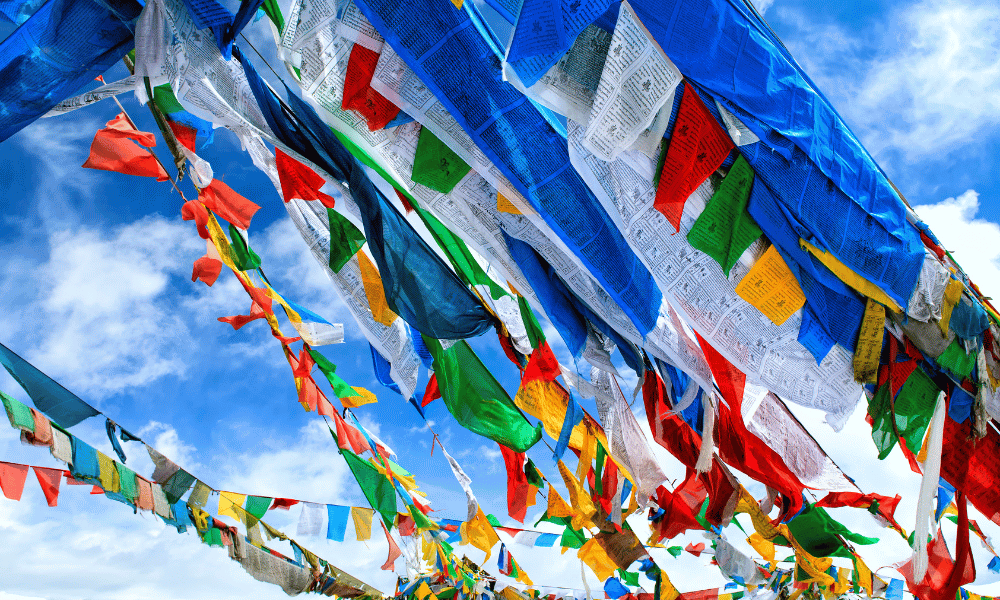 The Mani Rimdu Festival holds immense significance for the Sherpa people, as it serves as a celebration of their rich cultural heritage and spiritual beliefs. Rooted in Tibetan Buddhism, the festival provides an opportunity for the community to come together, strengthening their bond and reinforcing their shared identity. The intricate rituals, vibrant masked dances, and sacred ceremonies of Mani Rimdu not only reflect the depth of the Sherpas' religious devotion but also highlight their artistic and cultural prowess.
The Mani Rimdu Festival holds immense significance for the Sherpa people, as it serves as a celebration of their rich cultural heritage and spiritual beliefs. Rooted in Tibetan Buddhism, the festival provides an opportunity for the community to come together, strengthening their bond and reinforcing their shared identity. The intricate rituals, vibrant masked dances, and sacred ceremonies of Mani Rimdu not only reflect the depth of the Sherpas' religious devotion but also highlight their artistic and cultural prowess.
Experiencing the Mani Rimdu Festival is a truly transformative and unforgettable journey for visitors. It offers a rare glimpse into the world of Sherpa culture and Tibetan Buddhism, providing a deeper understanding of the beliefs and values that have shaped this remarkable community. As you immerse yourself in the festival, remember to respect local traditions, customs, and etiquette, ensuring that your presence enhances rather than disrupts this sacred event.
In conclusion, the Mani Rimdu Festival stands as a testament to the rich cultural heritage of the Sherpa people. It is a vibrant and captivating celebration that showcases their unique traditions, resilience, and spiritual depth. By attending the festival and honoring the customs of the Sherpa community, you not only contribute to the preservation of their culture but also gain a profound appreciation for the beauty and diversity of human experiences.
The Mani Rimdu Festival takes place during the tenth month of the Tibetan lunar calendar, called "Lha Bab," which typically falls in October or November. However, the exact dates can vary each year, so it's essential to confirm the schedule before planning your trip.
The Mani Rimdu Festival is celebrated in several monasteries across the Everest region, including Tengboche, Thame, and Chiwong. Each monastery offers its own unique aspects and experiences during the festival.
The Mani Rimdu Festival lasts for three days, with each day dedicated to a specific phase: Wong (Empowerment), Cham (Masked Dance), and Jinsak (Fire Puja and Rituals).
The Mani Rimdu Festival serves as a celebration of Sherpa culture and Tibetan Buddhist spirituality. It aims to promote spiritual growth, remove obstacles, and garner blessings from the deities, while also fostering a sense of community and preserving the unique heritage of the Sherpa people.
Yes, tourists are welcome to attend the Mani Rimdu Festival. It offers a rare opportunity to experience Sherpa culture and Tibetan Buddhist practices up close. However, visitors are expected to respect local customs, dress modestly, and follow proper etiquette during the festival.
During the Mani Rimdu Festival, you can expect to witness various rituals, prayers, and performances, including the creation of a sand mandala, vibrant masked dances (Cham), and the dismantling of the sand mandala followed by a procession. The festival is also characterized by elaborate costumes, intricate masks, and traditional music played on drums, cymbals, horns, and bells.
While it's not strictly necessary to hire a guide or join a group tour, doing so can enhance your overall experience. A local guide or reputable trekking agency can help you navigate the trekking route, provide information about the festival and local customs, and ensure that you have a safe and enjoyable journey.